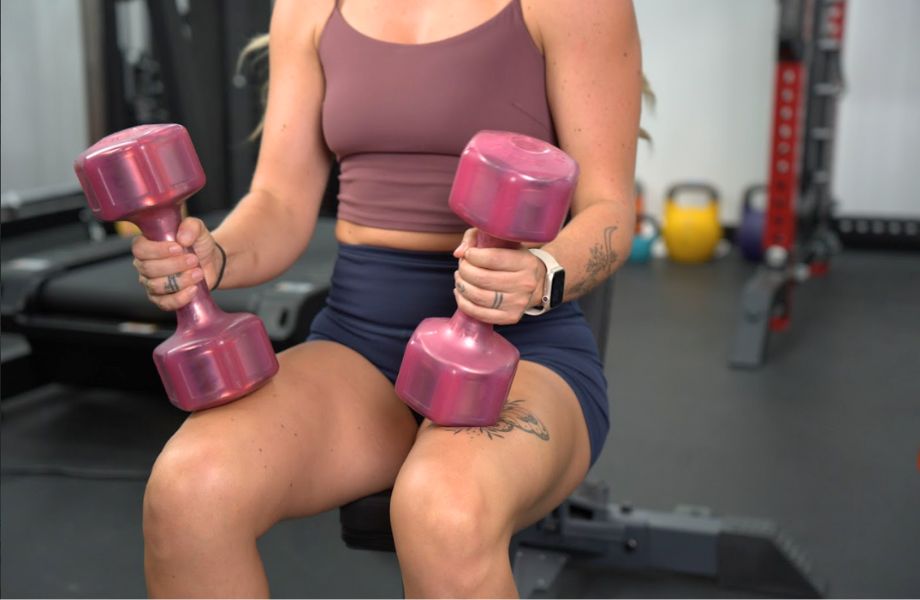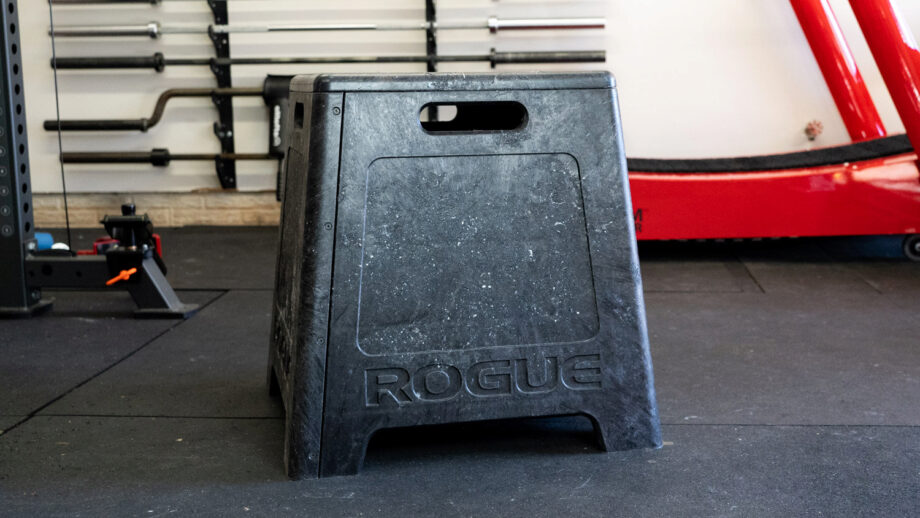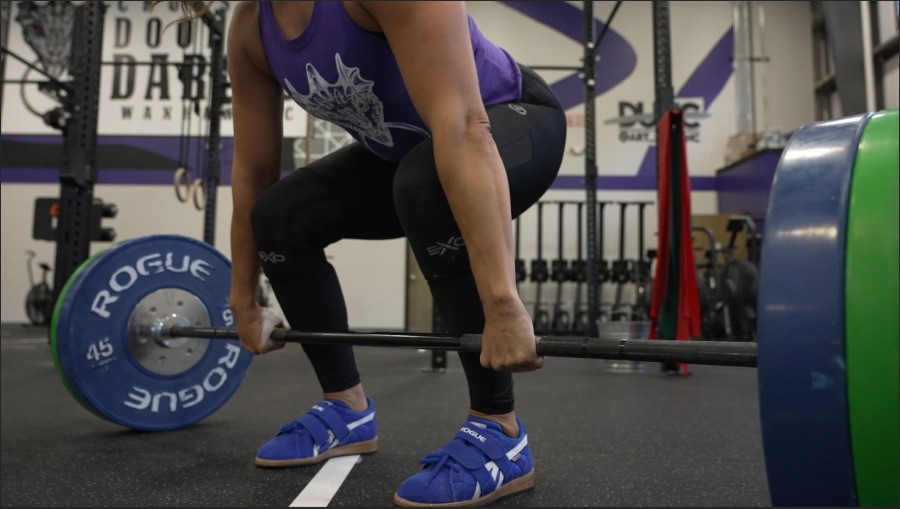Before you step into a gym environment—commercial or garage—knowing how to start lifting weights is important. Yes, you could wing it (plenty of people do!), but doing this may lead to strain or injury. “Why?” you ask. Well, the exercises you perform could be too advanced for a beginner or you may not yet understand the basics of weight training.
RELATED: Workout Schedule For Beginners
Even though bodybuilders make it look easy—”I lift things up and put them down”—the gym can be daunting for beginners. From cardio machines to fixed resistance machines, to free weights, to the best pull-up bars, there’s a lot of different equipment. Each exercise requires knowledge to keep you safe from injury. You’ll also want to know how to progress to continue making those #gains.
I’ve been a certified personal trainer (CPT) for over 10 years and will start this beginner’s guide by explaining all there is to know on how to start lifting weights. Then, I’ll describe seven beginner exercises and how to do them with good form. I’ll also share a sample beginner weightlifting workout and examine the health benefits of adding weights to your training sessions.
So, regardless of whether your fitness goal is losing weight or building muscle, let’s begin!
What Do You Need To Know To Start Lifting Weights?
To start lifting weights, you’ll want to know three things: the basics of the lift, how to stay safe, and how to increase your load to continue to see improvements.
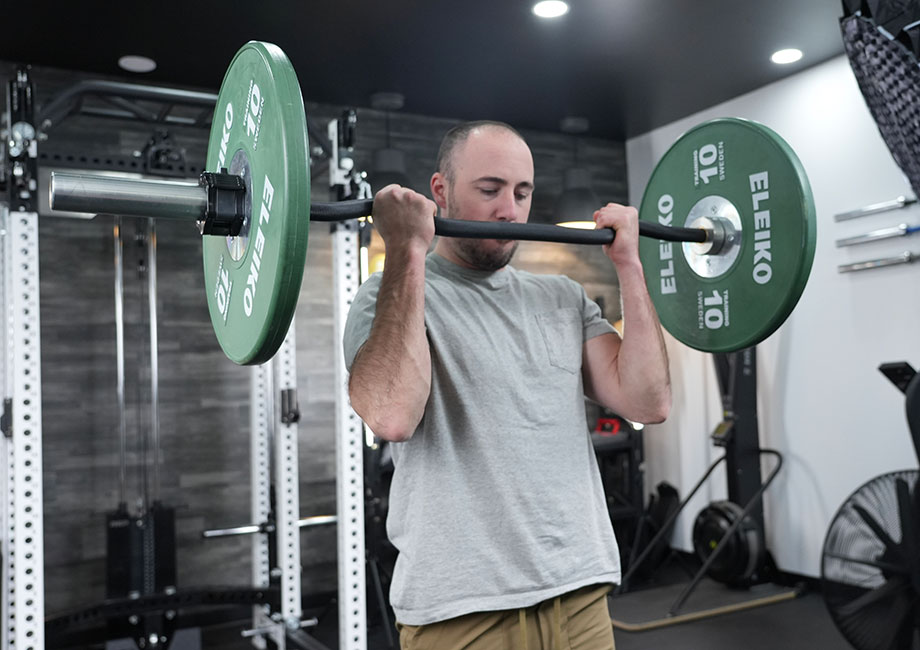
The Basics Of Lifting Weights
Here’s some key terminology:
- Reps or repetitions: The number of times you do a specific exercise before resting.
- Sets: The number of times you perform a group of repetitions of an exercise.
- Rest period: The length of time you rest between sets or exercises.
- Load: The amount of weight you lift.
- Volume: The total amount of work that you do in a specific period (usually calculated as the number of sets per muscle group).
- Frequency: The number of weight training sessions you do per week.
- One-rep max: The maximum amount of weight you can lift for one repetition.
- Compound exercises: Exercises that work multiple muscle groups at the same time.
- Isolation exercises: Exercises that target a specific muscle group.
- Intensity: The difficulty of the exercise is in relation to your one-rep max (see above).
- Hypertrophy: This is when your fitness goal is to build muscle mass.
Additionally, there are different types of resistance training exercises. You can use free weights (dumbbells, barbells, and kettlebells), fixed-resistance machines (chest fly machines, leg presses, and more), or your own body weight (for example, performing push-ups, pull-ups, and planks).
RELATED: What Is Resistance Training?
Safety Tips
Below are five tips to help you stay safe when lifting weights:
- Start with lighter loads. When you’re learning a new exercise, start light. You can progress to heavier loads once your exercise form becomes second nature.
- Drink plenty of water. Working out when you’re dehydrated can decrease your performance. Not only this, but you may feel faint during your training sessions.
- Warm-up and cool-down. Warming up improves your flexibility and increases blood flow to your muscles. Cooling down helps reduce general muscle soreness and the dreaded DOMS (delayed-onset-muscle soreness).
- Focus on the correct form. Form should always come first. To avoid injury, ensure that both the concentric (shortening of the muscle) and eccentric (lengthening of the muscle) phases of lifts are performed in a controlled manner. For more, check out our Concentric vs. Eccentric Training Guide.
- Take rest days. Overtraining can lead to injuries. To prevent this, schedule rest days into your workout routine, and more importantly, stick to them.
What Is Progressive Overload?
Progressive overload is when you increase the stimulus your body undergoes when lifting to increase your strength and make progress. If you perform the same workout routine time and time again, you’ll eventually reach a plateau with it. Instead, you can increase the load, number of reps, number of sets, range of motion, difficulty of exercise, or more to continue to see improvements.
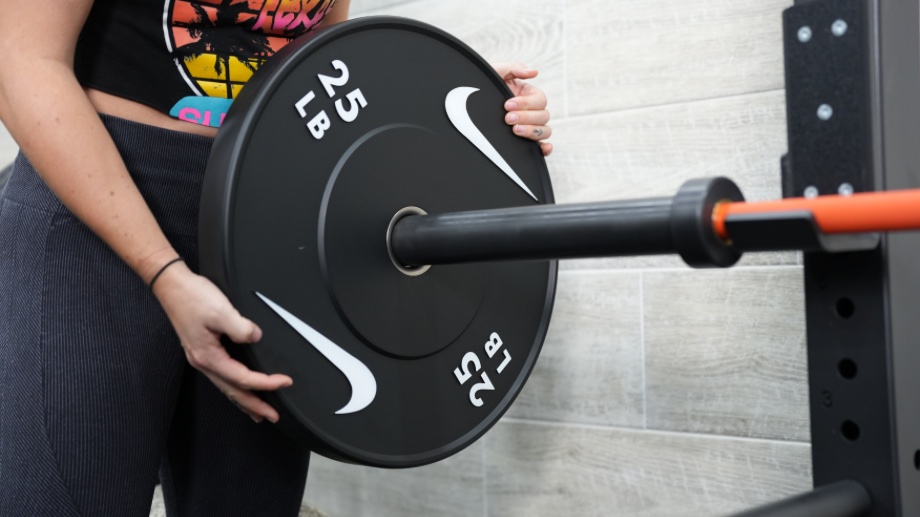
I’ve included progressive overload in this guide on how to start lifting weights because—as a certified personal trainer (CPT)—I often see it ignored. Let’s look at squats as an example. As a beginner, you’ll do bodyweight squats. Then, you can progress to goblet squats (you’ll see these below) before moving to back squats or front squats.
At all stages, you can increase the load, number of reps, number of sets, or more to benefit from progressive overload.
How To Start Lifting Weights: 7 Best Beginner Exercises
- Dumbbell Bench Press
- Bent-Over Row
- Dumbbell Biceps Curl
- Goblet Squat
- Dumbbell Lunges
- Triceps Extension
- Resistance Band Pull-Apart
Dumbbell Bench Press
Benefits: Regularly performing dumbbell bench presses helps build muscle mass in your chest, triceps, and shoulders. It’s also easier to learn the correct form on the dumbbell bench press than on the barbell bench press, which is why I’ve included them. Another advantage is that each side of the body works on its own (unilaterally) during dumbbell bench presses, helping to correct muscular imbalances.
How to do it:
- Sit down on a flat bench with a pair of dumbbells resting on your quadriceps. Your feet should be flat on the floor.
- Lie back, taking the dumbbells with you. Position the dumbbells near your chest region, just outside of your torso.
- Lift your chest, brace your core, and simultaneously press both dumbbells toward the ceiling.
- When your arms are extended and the dumbbells are touching, pause momentarily.
- Lower the dumbbells slowly back down to their starting position.
- Continue for the desired number of repetitions.
Expert tip: I’ve described the flat dumbbell bench press, but you can also try different bench variations using an incline bench. A 2020 study1 found that “An inclination of 30° produces greater activation of the upper portion of the pectoralis major. Inclinations greater than 45° produce significantly higher activation of the anterior deltoid and decrease the muscular performance of the pectoralis major.”
RELATED: 12 Best Weight Benches
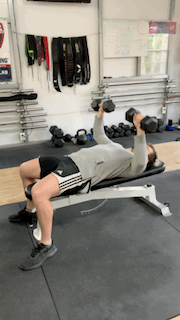
Bent-Over Row
Benefits: Bent-over barbell rows are one of my favorite resistance training exercises, and for good reason. You’ll activate both your upper body and lower body and improve your grip strength. And, because it’s a barbell exercise, you can lift heavier weights than with other row exercises involving dumbbells or fixed resistance machines.
How to do it:
- Place a loaded Olympic barbell on the floor.
- Step underneath the bar and grab it with an overhand grip (palms facing the floor).
- Deadlift the barbell to your pelvic region by driving through your heels.
- Bend your knees slightly and drive your hips backward until your torso is at roughly a 45-degree angle. The barbell will be close to your shins here.
- “Row” the bar by lifting it toward your abdominal region, ensuring your elbows are tucked into your body.
- Return the barbell to its original position in a controlled manner.
- Keep going for reps.
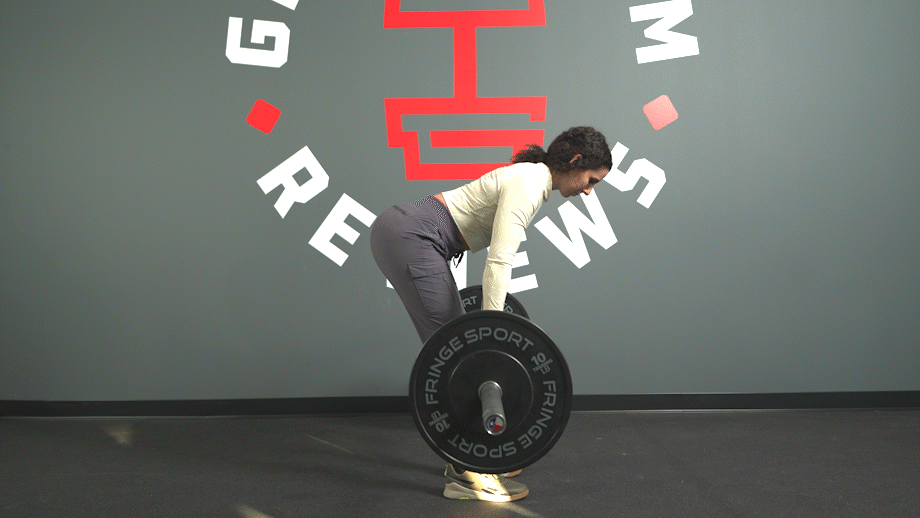
Dumbbell Biceps Curl
Benefits: Although you’ll need to use lighter weights for dumbbell biceps curls, they isolate the biceps and train each arm separately. With barbell curls, your stronger arm can help compensate for your weaker arm, but you won’t have this crutch with dumbbell biceps curls. You’ll also improve your grip and forearm strength.
How to do it:
- Stand tall, holding a dumbbell in each hand. Your feet should be shoulder-width apart, your arms should be straight, and you should hold the dumbbells with an underhand grip (palms facing away from your body).
- Engage your core before curling both dumbbells toward your shoulders. Pause.
- Slowly bring the dumbbells to their starting position.
- Repeat for repetitions.
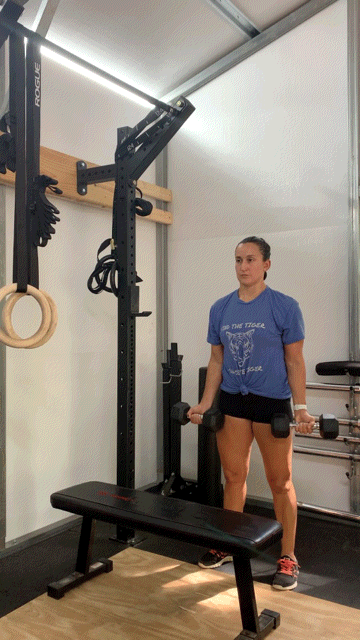
Goblet Squat
Benefits: Goblet squats are more challenging than bodyweight squats but don’t require as much time to learn the proper form as barbell squats. This makes them a great exercise for beginners who want to learn how to start lifting weights. Compared to landmine squats, goblet squats can better target quadriceps activity and increase vertical loading2.
How to do it:
- Stand upright with your feet hip-width apart. You’ll want to be holding either a single kettlebell or a dumbbell with both hands in front of your chest.
- Squeeze your glutes, tense your core, and keep your head neutral.
- Squat down, ensuring that your knees stay in line with your toes.
- When your quads are at least parallel to the ground (if not deeper), hold momentarily.
- Drive through both of your heels to return to the standing position.
- Repeat for reps.
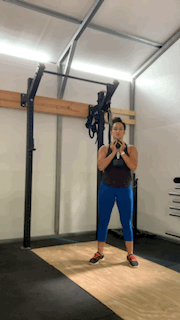
Dumbbell Lunges
Benefits: Adding dumbbell lunges to your training program helps to address bilateral deficits3 and fix muscular imbalances in the lower body. This is because they’re a unilateral exercise. Not only will you target your quads, hamstrings, glutes, and calves, but you’ll also activate your core and hip flexor muscles.
How to do it:
- Stand tall with a pair of dumbbells in each hand and your arms by your sides. Your feet should be hip-width apart.
- Brace your core before stepping your left foot forward.
- Bring your back knee (right knee) toward the ground while simultaneously bending your front knee (left knee).
- When your left quadricep is almost parallel to the floor, hold momentarily.
- Return to the standing position by driving your left foot into the ground.
- On the next rep, step your right foot forward.
- Continue for repetitions, alternating sides each time.
RELATED: What Muscles Do Lunges Work?
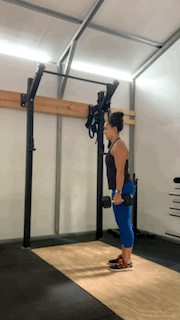
Triceps Extension
Benefits: The exercise I’ve described below is one of several fantastic triceps extension variations, all of which promote the health of your elbow joints and improve your lockout strength. This can help with other strength training exercises, such as dumbbell bench presses. You’ll also build bigger arms because your triceps make up roughly 70% of your upper arm.
How to do it:
- Stand upright with your feet shoulder-width apart. You’ll want to be holding either a single kettlebell or a dumbbell with both hands behind your head.
- Tense your core, then extend your arms so the kettlebell or dumbbell is directly above your head. You should ensure that your elbows remain in a fixed position here.
- Slowly return the equipment to its original position.
- Keep going for reps.
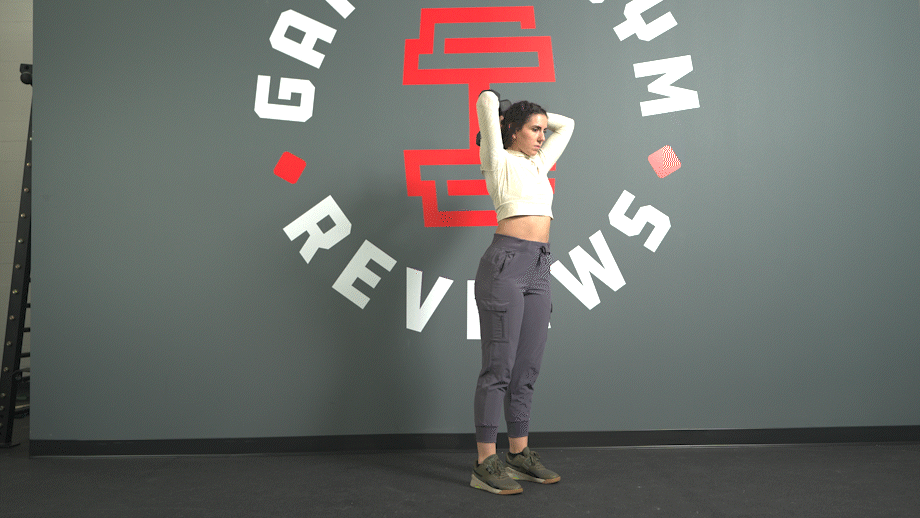
Resistance Band Pull-Apart
Benefits: Resistance band pull-aparts can either be done as a warm-up exercise or as a standalone exercise. For example, I enjoy doing them before heavy bent-over rows (see above) to lower the risk of injury. They’re also extremely convenient because all you need is one of the best resistance bands to perform them.
How to do it:
- Stand tall with your feet hip-width apart.
- Grab a resistance band with an overhand grip (palms facing the floor), and position your hands shoulder-width apart. Your arms should be extended in front of your body.
- Pull apart the resistance band so that your arms move laterally toward your sides. The band should lightly touch your upper chest region.
- Reverse the motion slowly until your arms are straight in front of you.
- Repeat for reps.
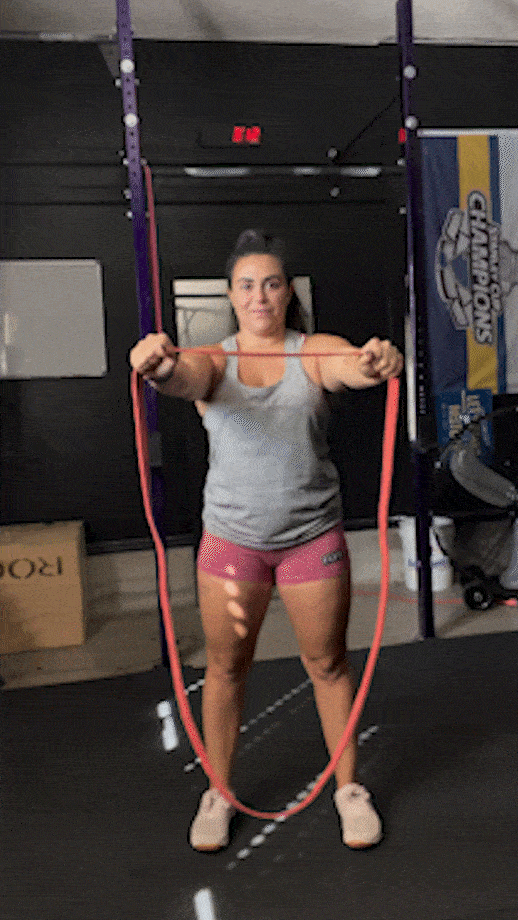
Sample Beginner Weightlifting Workout
Now that you have seven beginner weightlifting exercises, you can combine them into a workout routine. The below sample beginner weightlifting workout hits every muscle group in the body, and you can adapt them to your current fitness level:
| Exercise | Sets | Reps |
| Resistance Band Pull-Apart | 2 | 12 |
| Bent-Over Row | 4 | 6 |
| Goblet Squat | 3 | 8 |
| Dumbbell Bench Press | 4 | 8 |
| Dumbbell Lunges | 3 | 10, each side |
| Triceps Extension | 2 | 12 |
| Dumbbell Biceps Curl | 2 | 12 |
Rest for between one and two minutes between each set. As a certified personal trainer (CPT), I recommend warming up before starting this full-body workout. You’ll want to do a combination of light cardio and dynamic warm-up exercises—including examples like push-ups, inchworms, arm swings and circles, and leg swings.
What Are The Benefits Of Lifting Weights?
Why should you lift weights in the first place? Doing so may help you increase your strength and lean muscle mass, improve your bone density, and provide a better night’s sleep.
Helps Increase Strength and Lean Muscle Mass
Lifting weights helps to build strength and lean muscle mass. When you do any form of resistance training—whether using free weights or your own body weight—your muscle tissue tears. When you take rest days, consume sufficient protein, and eat properly, your body rebuilds these muscle fibers, leading to muscle growth.
Helps Improve Bone Density
When you lift weights regularly, you improve your bone density and decrease the risk of osteoporosis. A 2022 Sensors (Basel)4 study concurs—it found that “[A] strength training protocol seems to be effective in increasing bone mineral density among women with osteopenia/osteoporosis and represents an affordable strategy for preventing future bone loss.”
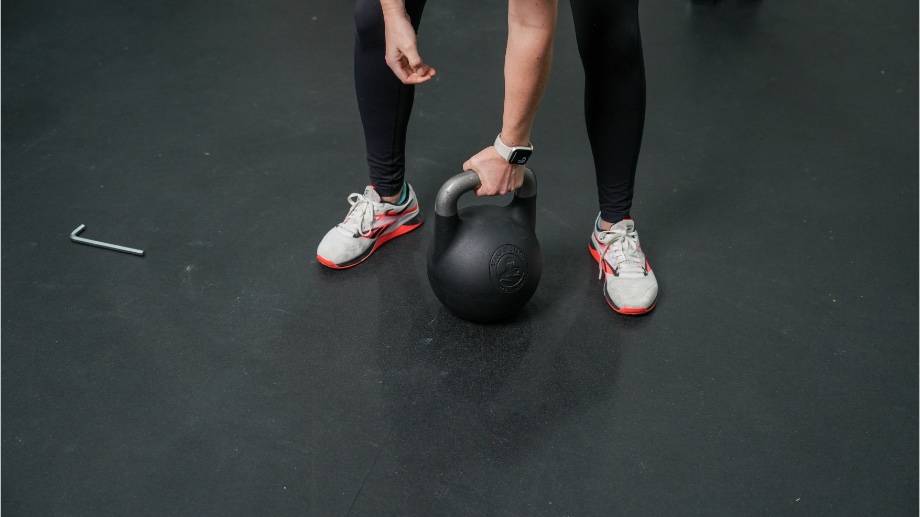
Provides a Better Night’s Sleep
A 2018 Sleep Medicine Reviews5 systematic review found that “Resistance exercise may be an effective intervention to improve sleep quality.” When I was younger—before I started weight training—I would struggle to get a proper night’s sleep. I would often lie awake in the middle of the night. Now, this rarely happens to me anymore, and part of the reason is because I lift weights.
How To Start Lifting Weights: Final Thoughts
Lifting weights can help increase your strength and lean muscle mass, improve bone density, and provide a better night’s sleep. Even though experienced gym-goers make it look easy, there are several important things to know about how to start lifting weights. There are different types of resistance training exercises—free weights, fixed resistance machines, and your body weight.
To stay safe when lifting weights, start with lighter loads, drink plenty of water, warm up and cool down, focus on the correct form, and take rest days. Additionally, with every exercise, use the concept of progressive overload by increasing the load, number of reps, number of sets, range of motion, and the difficulty of the to continue to see improvements.
You got this, Fit Fam!
How To Start Lifting Weights: FAQs
How should a beginner start lifting weights?
A beginner can start lifting weights by understanding key terminology, such as reps, sets, rest period, load, volume, frequency, one-rep max, compound exercises, isolation exercises, intensity, and hypertrophy.
Additionally, beginners can use the below tips to stay safe when lifting weights:
-Start with lighter loads
-Drink plenty of water
-Warm-up and cool-down
-Focus on the correct form
-Take rest days
How much weight should a beginner lift?
The amount of weight that a beginner should lift depends on the exercise. Some exercises, such as squats, push-ups, pull-ups, and lunges, will likely need no additional weight apart from your own body weight. Start light (between five and 20 pounds) for other exercises involving dumbbells or barbells, and see how you do. If the weight is too light, increase it.
Can beginners gain muscle quickly?
Yes, beginners can usually gain muscle quickly. There’s even a term for this—newbie gains. The reason for this is that strength training provides a new stimulus to your body that it isn’t used to. Your body tries to adapt to this, resulting in muscle mass. Beginners can also increase the load they lift at a quicker rate compared to experienced lifters, helping to add muscle.
How can I lift more as a beginner?
To lift more as a beginner, I recommend following a structured weightlifting program, such as Stronglifts 5×5 workout. With this workout routine, you increase the load on each exercise every time you do it, helping you lift more. Otherwise, lift weights consistently, eat sufficient protein, take rest days, and warm up properly to lift more as a beginner.
References
- Rodríguez-Ridao, D., Antequera-Vique, J.A., Martín-Fuentes, I., Muyor, J.M. (2020). Effect of Five Bench Inclinations on the Electromyographic Activity of the Pectoralis Major, Anterior Deltoid, and Triceps Brachii during the Bench Press Exercise. International Journal of Environmental Research and Public Health, 17(19):7339. doi: 10.3390/ijerph17197339. PMID: 33049982; PMCID: PMC7579505.
- Collins, K.S., Klawitter, L.A., Waldera, R.W., Mahoney, S.J., Christensen, B.K. (2021). Differences in Muscle Activity and Kinetics Between the Goblet Squat and Landmine Squat in Men and Women. Journal of Strength and Conditioning Research, 35(10):2661-2668. doi: 10.1519/JSC.0000000000004094. PMID: 34341315.
- Škarabot, J., Cronin, N., Strojnik, V., Avela, J. (2016). Bilateral deficit in maximal force production. European Journal of Applied Physiology, 116(11-12):2057-2084. doi: 10.1007/s00421-016-3458-z. Epub 2016 Aug 31. PMID: 27582260.
- Holubiac, I.Ș., Leuciuc, F.V., Crăciun, D.M., Dobrescu, T. (2022). Effect of Strength Training Protocol on Bone Mineral Density for Postmenopausal Women with Osteopenia/Osteoporosis Assessed by Dual-Energy X-ray Absorptiometry (DEXA). Sensors (Basel), 22(5):1904. doi: 10.3390/s22051904. PMID: 35271050; PMCID: PMC8915025.
- Kovacevic, A., Mavros, Y., Heisz, J.J., Fiatarone Singh, M.A. (2018). The effect of resistance exercise on sleep: A systematic review of randomized controlled trials.Sleep Medicine Reviews, 39:52-68. doi: 10.1016/j.smrv.2017.07.002. Epub 2017 Jul 19. PMID: 28919335.



